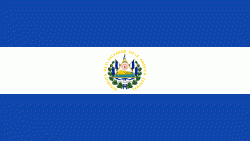Antiguo Cuscatlán (Antiguo Cuscatlán)
 |
The historic downtown sits on the foothills of La Cordillera del Bálsamo, and the city extends towards the Cordillera del Bálsamo on the south and on the foothills of the San Salvador Volcano on the north. The estimated per capita income for the city was $22,783 in 2013, which is 5.9 times higher than the national per capita (nominal).
According to Pipil texts Antiguo Cuscatlán was founded as Cuzcatlan in 1054 by Topiltzin Atzil, the last king of Tula of Anahuac. It was a city populated by ten thousand, with an additional twelve thousand people who lived in xacal, straw huts distributed at the edge of a maar (crater) which housed the sacred lake of Cuscatlan. In the contemporary Native language, Cuscatlán means Jewel City.
On Saturday June 17, 1524, led by Pedro de Alvarado, the Spanish conquistadors found the doors of Cuscatlan, capital of the Lordship of Cuscatlan. The company consisted of one hundred fifty units of infantry, cavalry and one hundred other slaves, prepared to attack the kingdom and take over the regional capital. Despite the resistance, the Spanish were victorious and incorporated the municipality into the domains of the Iberian metropolis.
The place was less relevant thereafter, as the town was caught in the dynamics of the rest of the country, which exploited its resources ending the colony. After the independence of Central America, San Salvador surpassed Antiguo Cuscatlan in importance, relegating it to a mere local capital.
In the present day, Antiguo Cuscatlan has gained an important edge, hosting major institutions, plazas, corporative headquarters and the biggest U.S Embassy of the region.
Map - Antiguo Cuscatlán (Antiguo Cuscatlán)
Map
Country - El_Salvador
 |
 |
| Flag of El Salvador | |
Among the Mesoamerican nations that historically controlled the region are the Lenca (after 600 AD), the Mayans, and then the Cuzcatlecs. Archaeological monuments also suggest an early Olmec presence around the first millennium BC. In the beginning of the 16th century, the Spanish Empire conquered the Central American territory, incorporating it into the Viceroyalty of New Spain ruled from Mexico City. However the Viceroyalty of New Spain had little to no influence in the daily affairs of the isthmus, which was colonized in 1524. In 1609, the area was declared the Captaincy General of Guatemala by the Spanish, which included the territory that would become El Salvador until its independence from Spain in 1821. It was forcibly incorporated into the First Mexican Empire, then seceded, joining the Federal Republic of Central America in 1823. When the federation dissolved in 1841, El Salvador became a sovereign state, then formed a short-lived union with Honduras and Nicaragua called the Greater Republic of Central America, which lasted from 1895 to 1898.
Currency / Language
| ISO | Currency | Symbol | Significant figures |
|---|---|---|---|
| SVC | Salvadoran colón | 2 | |
| USD | United States dollar | $ | 2 |
| ISO | Language |
|---|---|
| ES | Spanish language |















